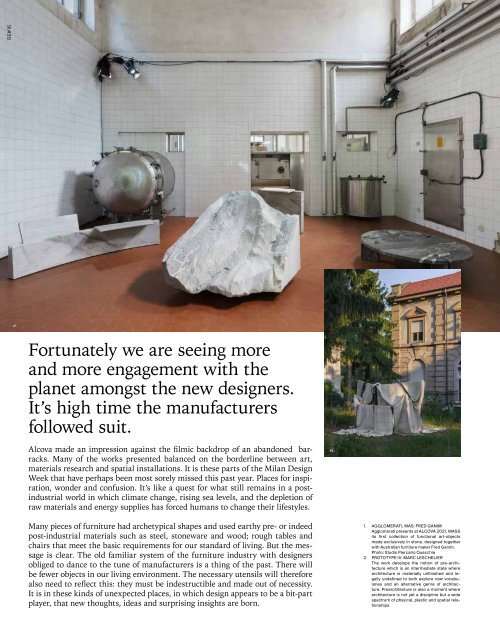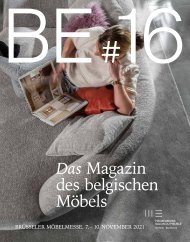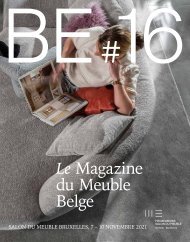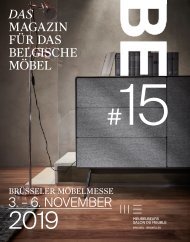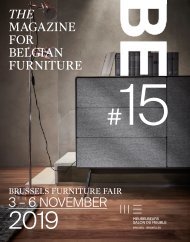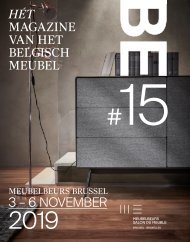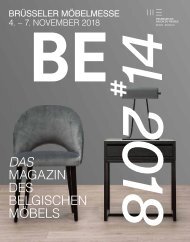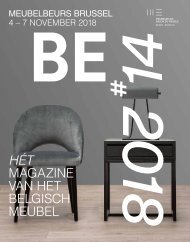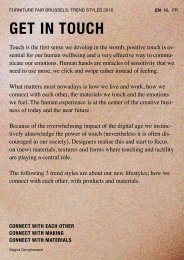You also want an ePaper? Increase the reach of your titles
YUMPU automatically turns print PDFs into web optimized ePapers that Google loves.
BE#16<br />
3. SCAU, UNEARTHED: ANNA SAINT PIERRE<br />
Compressed excavated earth from a SCAU architecture<br />
project in Clamart, France.<br />
Photo: SCAU Architecture<br />
4. CITRUS PARADIS: REPULP<br />
An eco-friendly material produced in France out of<br />
waste from the citrus juice industry and other renewable<br />
materials. Repulp is completely biobased<br />
and recyclable and offers a valid alternative to petrochemical-based<br />
materials. Repulp is later processed<br />
in a workshop in Marseille with a combination<br />
of handcraft and digital techniques resulting in<br />
small series of 3D printed objects featuring unique<br />
colours.<br />
5. MYCÉLIUM, STUDIO PAYET & MIMO<br />
In collaboration with Champiloop and the biolab<br />
Nemeton, the studio created a table lamp made of<br />
mycelium, a material which is available in large quantities<br />
and easily accessible. This little known material<br />
is becoming an alternative to cowhide and plastic.<br />
6. ALGA DESIGN: SAMUEL TOMATIS<br />
Tomatis created flexible materials made entirely of<br />
algae, which he is developing with scientists. With<br />
an appearance similar to leather or plastic, these<br />
materials are biodegradable.<br />
Photo: Florent Mulot<br />
7. SCAU, GRANITO: ANNA SAINT PIERRE<br />
Anna Saint Pierre’s in-situ recycling technique<br />
called Granito has been adopted by SCAU, the<br />
architecture firm for which she works. Granito –<br />
or ‘in-situ’ quarrying – involves the recycling of<br />
construction materials from building structures for<br />
the renovation of those buildings.<br />
Photo: SCAU Architecture<br />
France, responsible beauty<br />
The Maison&Objet trade fair focused on a lifestyle that is in harmony with nature,<br />
which makes use of technology to bring people together – sometimes virtually<br />
– and which at the same time draws upon the traditional expertise of crafts<br />
that have been passed down from generation to generation.<br />
Paris Design Week focused on a completely different kind of design: sustainability<br />
with a businesslike approach. All over the city, there were exhibitions about<br />
new and renewable materials to visit. Talks were organised that triggered an<br />
awareness of how we treat our planet.<br />
Various exhibitions showcased projects by designers who are carrying out research<br />
with recyclable and energy-efficient materials including seaweed, fungi<br />
and shells. We are invited to reconsider our approach to beauty and we are encouraged<br />
to seek it out in a frugal and sustainable way. Today’s ecological problems<br />
leave us all with no choice but to consider how things are produced. Disposable<br />
items, polluting products and non-sustainable production processes must<br />
make way for more responsible solutions.<br />
BRUSSELS FURNITURE FAIR<br />
6 7<br />
1.<br />
Fortunately we are seeing more<br />
and more engagement with the<br />
planet amongst the new designers.<br />
It’s high time the manufacturers<br />
followed suit.<br />
An appeal for the planet<br />
Alcova made an impression against the filmic backdrop of an abandoned barracks.<br />
Many of the works presented balanced on the borderline between art,<br />
materials research and spatial installations. It is these parts of the Milan Design<br />
Week that have perhaps been most sorely missed this past year. Places for inspiration,<br />
wonder and confusion. It’s like a quest for what still remains in a postindustrial<br />
world in which climate change, rising sea levels, and the depletion of<br />
raw materials and energy supplies has forced humans to change their lifestyles.<br />
2.<br />
3.<br />
4.<br />
5.<br />
Many pieces of furniture had archetypical shapes and used earthy pre- or indeed<br />
post-industrial materials such as steel, stoneware and wood; rough tables and<br />
chairs that meet the basic requirements for our standard of living. But the message<br />
is clear. The old familiar system of the furniture industry with designers<br />
obliged to dance to the tune of manufacturers is a thing of the past. There will<br />
be fewer objects in our living environment. The necessary utensils will therefore<br />
also need to reflect this: they must be indestructible and made out of necessity.<br />
It is in these kinds of unexpected places, in which design appears to be a bit-part<br />
player, that new thoughts, ideas and surprising insights are born.<br />
1. AGGLOMERATI, MAS: FRED GANIM<br />
Agglomerati presents at ALCOVA <strong>2021</strong>, MASS<br />
its first collection of functional art-objects<br />
made exclusively in stone, designed together<br />
with Australian furniture maker Fred Ganim.<br />
Photo: Studio Piercarlo Quecchia<br />
2. PROTOTYPE IV: MARC LESCHELIER<br />
The work develops the notion of pre-architecture<br />
which is an intermediate state where<br />
architecture is materially unfinished and legally<br />
undefined to both explore new vocabularies<br />
and an alternative genre of architecture.<br />
Prearchitecture is also a moment where<br />
architecture is not yet a discipline but a wide<br />
spectrum of physical, plastic and spatial relationships.<br />
6.<br />
7.


